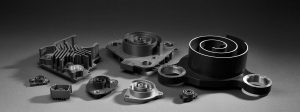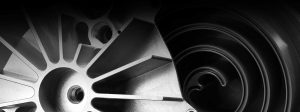Air Squared News
Air Squared Helps Inogen Oxygen Concentrator
Rotary scroll compressor helps new Inogen One oxygen concentrator break sound, weight, and battery-life barriers.

March 2005 – In a classic business-plan scenario of defining a market’s “wants” and then satisfying them, start-up-company Inogen Corporation has developed a new oxygen concentrator that is not only truly portable, but also nearly triples the time respiratory patients requiring supplemental oxygen can ambulate freely on battery power alone. According to the company, the revolutionary Inogen One concentrator creates a new class of “independent” oxygen devices – serving as either portable or stationary – by leading the industry in three key “quality of life” areas for patients: lightest weight, longest battery life, and low noise. The Inogen One attained these goals largely by breaking away from the industry-standard piston pump and selecting a rotary scroll compressor from Air Squared as its prime mover, said Geoff Deane, Inogen VP of Engineering/CTO. Developed by Colorado-based Air Squared and licensed exclusively to Inogen for use in oxygen concentrators, the scroll compressor delivers more than 80% volumetric efficiency, while drawing less than 40 watts. The Inogen One itself operates in the sub-40 dBA range, a fraction of what’s considered acceptable in the industry, Deane stated
Business Students Correctly Diagnose Concentrator Market

Creation and marketing of the Inogen One were mapped out by three college students in 2001 as their entry in a business plan competition at the Center for Entrepreneurship and Engineering Management at the University of California Santa Barbara. After winning the competition, they went on to found the company, convincing one of the judges, Kathy Odell, to become CEO, and another one of the judges to help them with funding.
They had correctly read the market pressures that were building to cause a major shift in available technology.
Geoff Deane, Inogen VP of Engineering/CTO
Patients are being diagnosed with chronic obstructive pulmonary disease (COPD) earlier in life, and they wanted affordable solutions that provided greater quality of life, primarily easier ambulation and more of it. This required breakthrough design to achieve targets for weight, battery life, low noise, and long product life.
Existing products are almost exclusively stationary, designed for in-home use, and though reliable and low-cost, they sacrifice on “quality of life” in the areas of noise and vibration. The only portable device available at the time had a battery life of less than 50 minutes, noise level of 55 dBA, and required overhaul at 3000 hours.
To achieve the kind of miniaturization and reliability we were targeting, we had to optimize each subsystem, starting with the compressor, which consumes about 80% of the energy. We spent a lot of development effort to attain higher efficiency in the pressure swing adsorption cycle. And we invested in development of a very sensitive conserver, as well as miniaturization of the electronics and the software we use to manage operation of the device – all with the goal of reducing the amount of work the machine has to do.
Geoff Deane, Inogen VP of Engineering/CTO
Critical performance criteria for the compressor included low noise/vibration, long life, oil-free operation, light weight, low energy use, and ability to deliver precise flow and pressure. Starting in August 2002, Deane says the team researched more than a dozen alternatives including helical, rotary vane, piston pumps and others from the largest and best-known names around the world.
Until we came upon Air Squared’s rotary scroll compressor, a piston pump was the only device that came close in the pressure and size range we needed, and it would have required work to isolate the noise and vibration caused by valves and balance issues.Geoff Deane, Inogen VP of Engineering/CTO
Scroll Gives “New Spin” to Compressor Technology
The scroll compressor design is based on a 1900-era patent and 1970s refrigeration compressor technology. Under development by Air Squared, it has evolved into a new kind of air compressor that runs quietly and oil-free. The operating element of a scroll compressor is made up of two identical involutes which form right- and left-hand components. One scroll is indexed or phased 180 degrees with respect to the other to allow the scrolls to mesh. This indexing creates crescent shaped gas pockets, bounded by the involutes and base plates of both scrolls.
In operation, one scroll remains fixed; the other is attached to an eccentric, driven by an electric motor. As the moving scroll orbits around the fixed scroll, the pockets formed by the meshed scrolls follow the spiral toward the center and diminish in size. The compressor inlet is at the periphery of the scrolls. The entering gas is trapped in two diametrically opposed gas pockets and compressed as the pockets move toward the center, where the discharge port is located in the fixed scroll. No valves are needed because the discharge port is isolated from the inlet. This reduces noise and improves the durability of the unit.
Because scroll compressors use true rotary motion, they can be dynamically balanced for nearly vibration-free operation. Air delivery is continuous, which virtually eliminates inlet or discharge pulsation and associated noise. Reliability is inherent, because there are only two primary moving parts, with no inlet or discharge valves to break or make noise, and no associated valve losses.
Rotary Motion of Compressor is Inherently Quiet
We researched the scroll compressor in depth, and determined it could give us a big advantage right off the starting line because we had very little noise or vibration to isolate. Air Squared conducted additional development and customization for us to reduce energy consumption of the compressor by 40% through tweaking the manufacturing process and through a proprietary technology – now patented – that greatly improved the sealing of the oil-free machine.Geoff Deane, Inogen VP of Engineering/CTO
Air Squared also developed a unique way of fine-tuning the discharge flow of the compressor so that each unit delivered the required rate ±0.2 l/min.
The scroll compressor inside the Inogen One weighs just two pounds, including its motor, and measures only 4.5″ x 3″ x 3.3″ (LWH). The entire Inogen One weighs less than 10 pounds, including its battery, and measures about 12″ x 6″ x 12″ (LWH).
Its pulse-dose delivery system delivers 1-5 l/min in nine flow settings, varying the speed of the compressor from 1500-2700 rpm to meet demand. The lithium ion battery provides 2-3 hours of independent use on a 3-hour recharge, with AC and DC capability for stationary and mobile operation, while concurrently charging the battery. The system is covered by a 3-year limited warranty.
Inogen received FDA marketing clearance for its new oxygen concentrator in May 2004, and began shipping in October. The company has received enthusiastic response from the home oxygen community, and is working to scale up production in a controlled manner to meet demand. Deane adds the company is protecting its technology lead with multiple patent filings.





